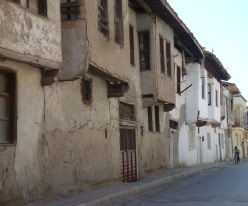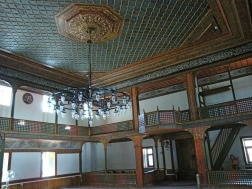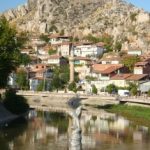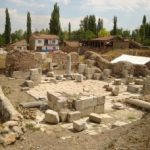He came, he saw, he conquered Population: 33,600
Old name: Zela, Anzila, Gırgırye
Market days: Tuesday and Friday
South of Amasya, this small inland town is famous as the place where, in 47 BC, Julius Caesar uttered his immortal words Veni, vidi, vici (I came, I saw, I conquered). He had just defeated Pharnaces, the son of Mithridates VI Eupator, who had led a Pontic revolt against the Romans at the Battle of Zela.
Once you arrive here, however, there’s precious little to show for Caesar. Instead you’ll be stunned – and hopefully delighted – to find that Zile retains one of Turkey’s most complete Ottoman townscapes, with street upon street of small wood and plaster houses interspersed with the odd grand konak (mansion). What makes this so especially remarkable is that most of the houses are still lived in when so often the old houses in city centres are just shattered shells. 
The remains of a castle said to date back to Pontic times still survive above the modern town. The walls and the tower over the entrance have recently been completely rebuilt and the interior is now a large and lively picnicking area with a tea garden and a few sad animals (including dogs) and birds in cages. Scattered about are reminders of the more ancient past, with bits of sarcophagi and old gravestones with Ancient Greek inscriptions. The views out over the red-tiled roofs of the different mahalles are magnificent.
Inside the castle a marble column inscribed with Caesar’s famous words is said to have been placed there by him but there is no confirmation of its authenticity.
Around town
The Ottoman houses aside, Zile also has a number of old mosques, hamams and other structures dotted about.
If you come by bus you should get out in front of the Taceddin İbrahim Paşa Hamam which dates back to 1494 and was restored in the 2010s. It was once part of a mosque complex that included the pretty brick-built mosque uphill behind it that was built in 1497. That, however, was largely rebuilt in 1640 when it was renamed the Boyacı Hasan Ağa Cami after its new benefactor.
Facing the hamam across the road is the Bedesten Cami, which started life in 1495 as a market building in the same complex. Converted into a mosque, it was badly damaged by an earthquake in 1939 but has since been repaired and reopened.
Nearby is the Ulu (Nasuh Paşa) Cami which suffered badly in an earthquake and was largely rebuilt between 1901 and 1909. The original mosque was a work of 1267 paid for by Mehmed Zaluli during the reign of the Selçuk leader, Gıyaseddin Keyhüsrev. The huge dome has been beautifully repainted.
 But perhaps the most beautiful of all the mosques is actually the much newer (19th century) Elbaşoğlu Cami that you pass on the left as you come into town. Not particularly special from the outside, it turns out to have a spectacularly beautiful wooden interior with a lovely carved ceiling surrounded by an elegant calligraphic inscription and paintings of flowers. It’s a style that could almost be called folk art but here works a treat. There is another like it in Yozgat town centre apparently.
But perhaps the most beautiful of all the mosques is actually the much newer (19th century) Elbaşoğlu Cami that you pass on the left as you come into town. Not particularly special from the outside, it turns out to have a spectacularly beautiful wooden interior with a lovely carved ceiling surrounded by an elegant calligraphic inscription and paintings of flowers. It’s a style that could almost be called folk art but here works a treat. There is another like it in Yozgat town centre apparently.
In the town centre the grand Ottoman-era Gaydaroğlu Konaği has been restored as a cultural centre.
Sleeping
There’s a better choice of places to stay in nearby Tokat.
Zerze Butik Hotel. Tel: 0356-317 6878
Transport info
There are buses every half-hour or so from Turhal (20km).


